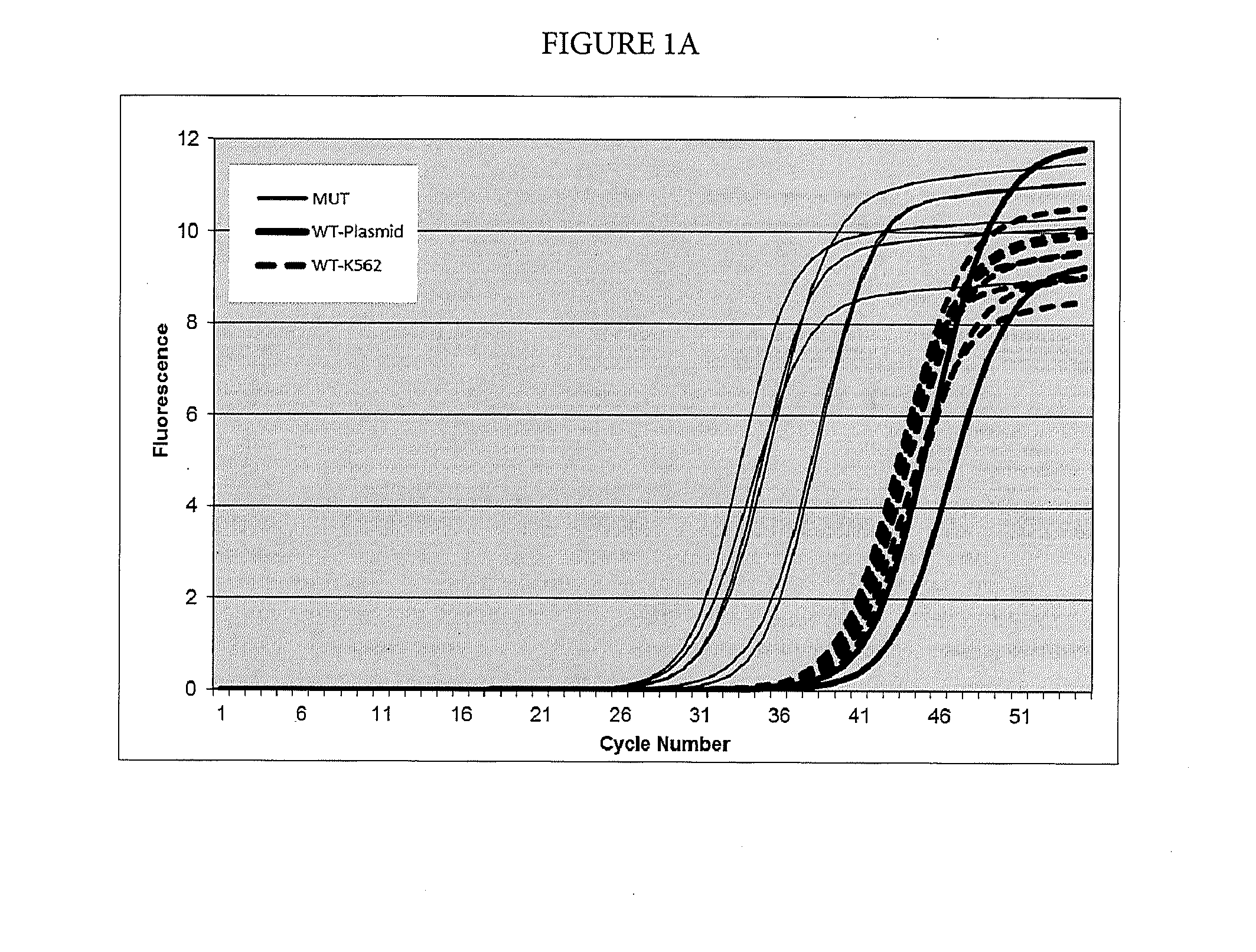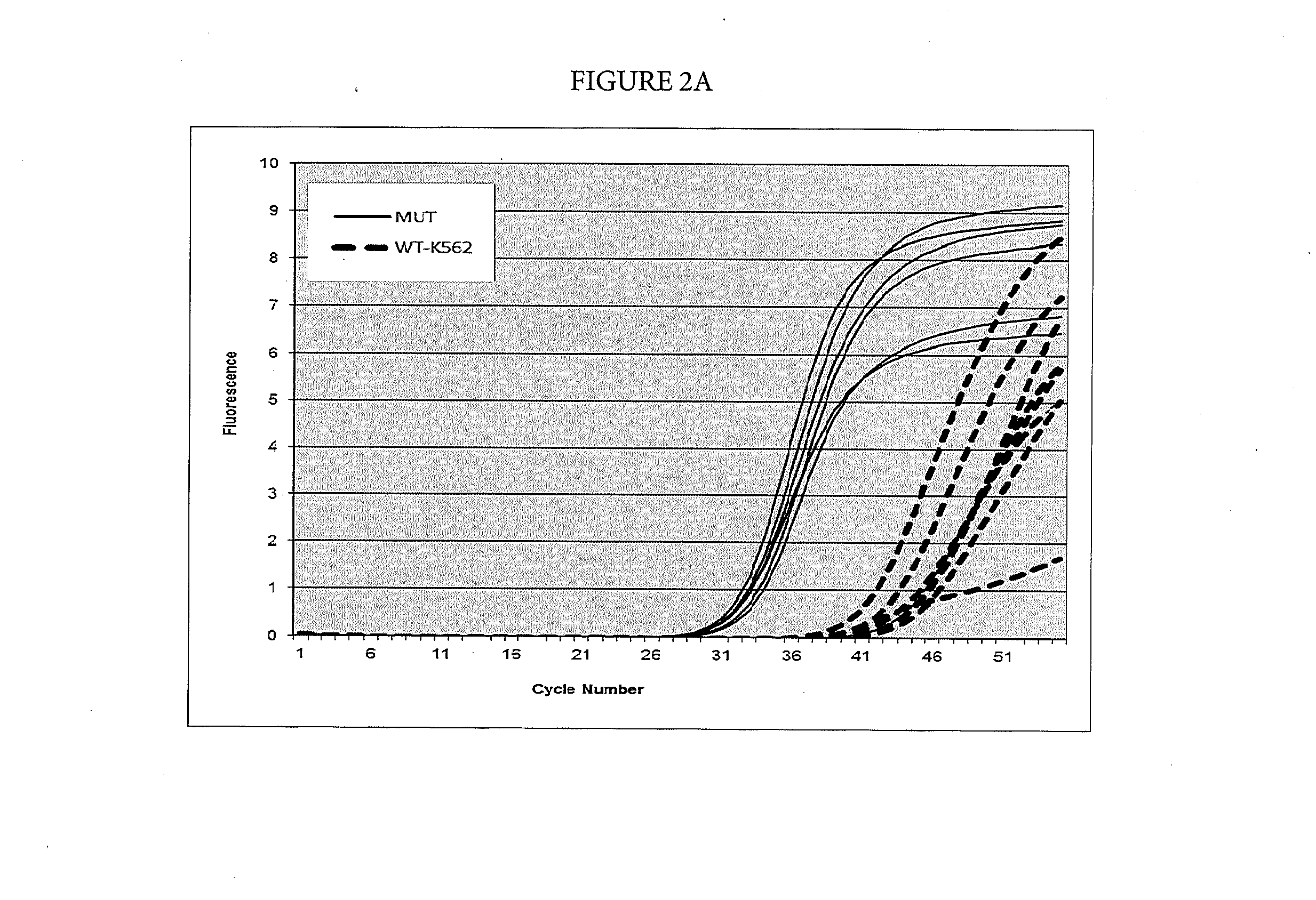Suppression of Non-Specific Amplification with High-Homology Oligonucleotides
a technology of high-homology oligonucleotide and non-specific amplification, which is applied in the field of suppression of non-specific amplification with high-homology oligonucleotides, can solve the problems of misdirecting the patient's therapy, the inability to achieve ideals, and the inability to completely avoid amplification of non-target sequences. achieve the effect of reducing non-specific amplification
- Summary
- Abstract
- Description
- Claims
- Application Information
AI Technical Summary
Benefits of technology
Problems solved by technology
Method used
Image
Examples
example 1
[0070]Suppression of Breakthrough Amplification by a PCR Primer
[0071]In this example, suppression of breakthrough amplification was observed in an AS-PCR targeting mutations in codon 12 of the human NRAS gene. The primers and probes used in Example 1 are shown in Table 2. An upstream primer selected from among SEQ ID NOs: 6-23 is matched to one of the mutations 35G>C, 34G>T, 35G>A, 34G>C, 34G>A, and 35G>T corresponding to amino acid changes G12A, G12C, G12D, G12R, G12S, and G12V in exon 2 of the human NRAS gene and is mismatched with the wild-type sequence. A downstream primer selected from SEQ ID NOs: 24-26 is common between the mutant and wild-type sequences of exon 2 in the human NRAS gene and the detection probe is selected from SEQ ID NOs: 27-29.
TABLE 2Primers and probes for exon 2 of the NRAS gene used in Example 1.SEQ ID NO:FunctionSequence 5′-3′SEQ ID NO: 635G > C AS primerCTGGTGGTGGTTGGAGCCGCSEQ ID NO: 735G > C AS primerCTGCTGGTGGTTGGAGEAGCSEQ ID NO: 835G > C AS primerCTGCT...
example 2
[0074]Suppression of Breakthrough Amplification by an Additional Suppressor Oligonucleotide
[0075]In this example, suppression of breakthrough amplification was observed in an AS-PCR targeting mutations in codon 61 of the human NRAS gene. The primers and probes used in Example 2 are shown in Table 3. An upstream primer selected from among SEQ ID NOs: 30-47 is matched to one of the mutations 183A>T, 183A>C, 181C>A, 182A>T, 182A>C, 182A>G corresponding to amino acid changes Q61Ha, Q61Hb, Q61K, Q61L, Q61P, and Q61R in the human NRAS gene and is mismatched with the wild-type sequence. A downstream primer selected from among SEQ ID NOs: 48-50 and detection probe selected from among SEQ ID NOs: 51-53 are common between the mutant and wild-type sequences in exon 3 of the NRAS gene. Suppressor oligonucleotides selected from among SEQ ID NOs: 1-5 do not hybridize to any of the amplicons defined by the primer pairs used in this example.
TABLE 3Primers and probes for exon 3 of the NRAS gene used...
example 3
[0078]Suppression of Breakthrough Amplification of the Unrelated Template PI3KCA by a Suppressor Oligonucleotide
[0079]In this example, suppression of breakthrough amplification was observed in an AS-PCR targeting mutations in codon 1049 of the human PI3KCA gene. The primers and probes used in Example 3 are shown in Table 4. An upstream primer selected from among SEQ ID NOs: 54-56 is matched to the mutation 3145G>C corresponding to the amino acid change G1049R in the human PI3KCA gene and is mismatched with the wild-type sequence. A downstream primer selected from among SEQ ID NOs: 57-59 and a probe selected from among SEQ ID NOs: 60 & 96 and 61 & 97 are common between the mutant and wild-type sequences. Suppressor oligonucleotides selected from among SEQ ID NOs: 1-5 (specific for the human NRAS gene) do not hybridize to the PI3KCA amplicons used in this example.
TABLE 4Primers and probes for the PI3KCA gene used in Example 3.SEQ ID NO:FunctionSequence 5′-3′SEQ ID NO: 543145G > C AS p...
PUM
| Property | Measurement | Unit |
|---|---|---|
| temperature | aaaaa | aaaaa |
| size | aaaaa | aaaaa |
| concentration | aaaaa | aaaaa |
Abstract
Description
Claims
Application Information
 Login to View More
Login to View More - R&D
- Intellectual Property
- Life Sciences
- Materials
- Tech Scout
- Unparalleled Data Quality
- Higher Quality Content
- 60% Fewer Hallucinations
Browse by: Latest US Patents, China's latest patents, Technical Efficacy Thesaurus, Application Domain, Technology Topic, Popular Technical Reports.
© 2025 PatSnap. All rights reserved.Legal|Privacy policy|Modern Slavery Act Transparency Statement|Sitemap|About US| Contact US: help@patsnap.com



